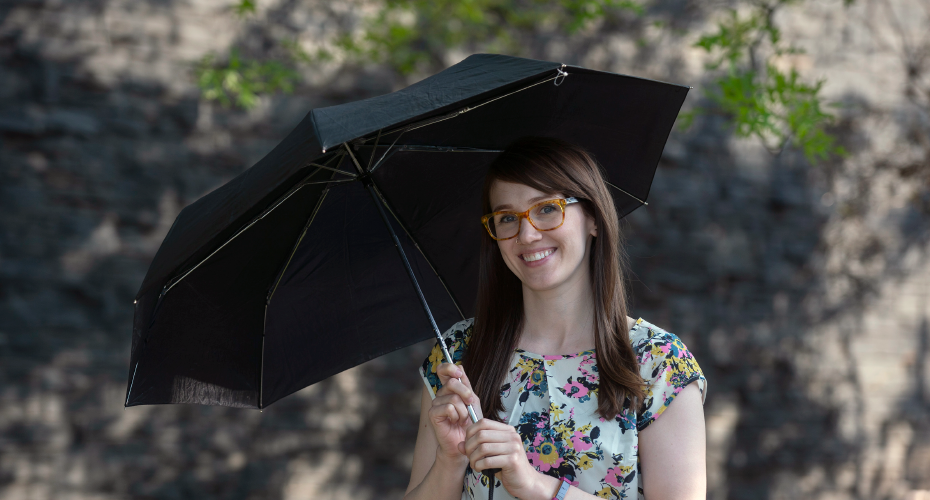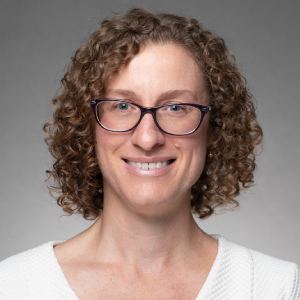Aug 13, 2019
Dark side of the sun
Like many teens, Laura Kocubinski once enjoyed long summer days by the pool and the beach and trips to the tanning salon with her older sister.
“I wanted to be less pale and to feel more confident,” she said, recalling that she disliked being teased for her pale skin, and always felt prettier with a tan.
She never thought she would one day hear the words, “You have cancer.”
Last July, Kocubinski, who is in her late 20s and lives in Allston, found a strange-looking mole on her left calf and went to her dermatologist to get it checked out. Eight days later, she was diagnosed with Stage I melanoma, an invasive form of skin cancer that can spread to other parts of the body if left untreated.
“Getting diagnosed with melanoma was shocking to me,” she said. “I was really upset. I felt young to be diagnosed with cancer.” She lived an active life, running three or four times a week and often hiking with her boyfriend.
“People think skin cancer is no big deal, but it’s cancer,” Kocubinski said. “I’m definitely guilty of not heeding the warnings. I thought, ‘That’s never going to happen to me.’ But it can happen to anyone. I understand why younger women in particular want to go tanning or lay out in the sun, but I would urge people to be sun-safe because you could get skin cancer.”'
Last summer, Kocubinski and her boyfriend canceled their trip to Acadia National Park in Maine so she could have surgery to remove the tumor, which left a 3-inch long incision and a permanent indentation on her leg where a surgeon removed the tissue down to the muscle.
As a graduate student majoring in computer science, Kocubinski has taken an innovative approach to her illness: she developed a program that uses machine learning to detect melanoma from an image of a mole, which she’s been using for her own skin checks.
She is cancer-free a year later and is able to be as active as she was before her surgery.
However, she says, “I still fear that the cancer might come back later in life,” a possibility with melanoma, the most dangerous form of skin cancer.
Skin cancer is the most common form of cancer in the U.S.
According to a Blue Cross Blue Shield Association survey, 31 percent of millennials nationwide use tanning beds to get a baseline tan, 53 percent believe a tan makes a person look healthy, and 58 percent believe a tan makes a person look attractive.
“Exposure to sun without appropriate sunscreen can be very dangerous to your health,” said Dr. Katherine Dallow, medical director at Blue Cross Blue Shield of Massachusetts. “That’s my message to young people, particularly young women. Your health matters far more than any benefit you think you might get from a tan.”
Dr. Rachel Reynolds, a dermatologist at Beth Israel Deaconess Medical Center, said by far the majority of her office visits are related to skin cancer, particularly less invasive forms such as basal cell carcinoma and squamous cell carcinoma.
“Skin cancer is the most common cancer diagnosis, and the incidence is going up,” she said.
How to protect yourself
Doctors recommend these sun safety tips:
- Apply sunscreen with an SPF of 30 or higher and a broad spectrum UVA and UVB protection on all exposed skin and reapply it every two hours regardless of SPF rating. Also make sure the suncreen is relatively new, since its effectiveness can decline over time.
- Wear sunglasses, a wide-brimmed hat and long-sleeved shirt to physically block the sun’s rays
- Avoid the sun as much as possible—especially the midday sun—by opting for the shade when you’re outside
- Refrain from using indoor tanning devices
- Get a baseline skin cancer screening with your primary care provider or dermatologist
- Do monthly skin exams by remembering your ABCDEs: Asymmetry (half of the mole doesn’t match the other), Border irregularity, Color that is not uniform, Diameter greater than 6 millimeters (about the size of a pencil eraser), and Evolving size, shape or color.
“Find a sunscreen you like and slather it on. And keep reapplying because sweat and water can wash it off,” said Dr. Tom Hawkins, senior medical director of population health and analytics. He added even in the winter, people should wear sunscreen when they’re outside because the sun’s rays can reflect off the snow and cause a sunburn. “If you’re going to be in direct sunlight, make sure to apply sunscreen,” he said.
Enjoying summer
Kocubinski takes all of these preventive measures and more to stay sun safe, even using an umbrella outdoors on especially sunny days. She also tries to lead a healthy lifestyle to prevent future cancers by eating well, exercising and practicing mindfulness.
“I’m really vigilant about any changes in my skin, and I’ve made a big effort to be as healthy as I can be and to be safe about sun exposure,” she said.
Although her diagnosis caused her to cancel her trip to Acadia last July, this summer, she and her boyfriend are going to begin hiking New Hampshire’s 4,000 footers—48 mountain peaks with an elevation of more than 4,000 feet—starting with Mount Washington in July.
“This experience makes you appreciate that we’re not here forever, we’re not guaranteed to be here tomorrow. It really lit a fire under me to do the things now that I want to do and not be complacent and to appreciate every day and appreciate the moments more,” she said.
As a cancer survivor, Kocubinski has already braved one of the biggest mountains of all.

